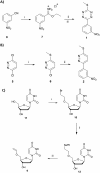Tetrazine-mediated bioorthogonal prodrug-prodrug activation
- PMID: 30288239
- PMCID: PMC6148199
- DOI: 10.1039/c8sc02610f
Tetrazine-mediated bioorthogonal prodrug-prodrug activation
Abstract
The selective and biocompatible activation of prodrugs within complex biological systems remains a key challenge in medical chemistry and chemical biology. Herein we report, for the first time, a dual prodrug activation strategy that fully satisfies the principle of bioorthogonality by the symbiotic formation of two active drugs. This dual and traceless prodrug activation strategy takes advantage of the INVDA chemistry of tetrazines (here a prodrug), generating a pyridazine-based miR21 inhibitor and the anti-cancer drug camptothecin and offers a new concept in prodrug activation.
Figures





Similar articles
-
The Emerging Role of Tetrazines in Drug-Activation Chemistries.Chembiochem. 2019 Apr 1;20(7):872-876. doi: 10.1002/cbic.201800590. Epub 2019 Jan 16. Chembiochem. 2019. PMID: 30394615
-
Polymeric PEG-based bioorthogonal triggers for prodrug activation in breast cancer.RSC Adv. 2025 Mar 5;15(9):7127-7138. doi: 10.1039/d4ra08758e. eCollection 2025 Feb 26. RSC Adv. 2025. PMID: 40045955 Free PMC article.
-
Tetrazine-Mediated Bioorthogonal System for Prodrug Activation, Photothermal Therapy, and Optoacoustic Imaging.ACS Appl Mater Interfaces. 2019 Nov 13;11(45):41875-41888. doi: 10.1021/acsami.9b13374. Epub 2019 Oct 31. ACS Appl Mater Interfaces. 2019. PMID: 31638763
-
Activation and Delivery of Tetrazine-Responsive Bioorthogonal Prodrugs.Molecules. 2020 Nov 30;25(23):5640. doi: 10.3390/molecules25235640. Molecules. 2020. PMID: 33266075 Free PMC article. Review.
-
Advances in the Delivery, Activation and Therapeutics Applications of Bioorthogonal Prodrugs.Med Res Rev. 2025 May;45(3):887-908. doi: 10.1002/med.22095. Epub 2024 Dec 18. Med Res Rev. 2025. PMID: 39692238 Review.
Cited by
-
Symbiotic prodrugs (SymProDs) dual targeting of NFkappaB and CDK.Chem Biol Drug Des. 2020 Aug;96(2):773-784. doi: 10.1111/cbdd.13684. Epub 2020 Apr 22. Chem Biol Drug Des. 2020. PMID: 32237047 Free PMC article.
-
Solid-Phase Synthesis of s-Tetrazines.Org Lett. 2023 May 5;25(17):3104-3108. doi: 10.1021/acs.orglett.3c00955. Epub 2023 Apr 21. Org Lett. 2023. PMID: 37083299 Free PMC article.
-
Isonitrile-responsive and bioorthogonally removable tetrazine protecting groups.Chem Sci. 2019 Nov 5;11(1):169-179. doi: 10.1039/c9sc04649f. eCollection 2020 Jan 7. Chem Sci. 2019. PMID: 32110368 Free PMC article.
-
"Close-to-Release": Spontaneous Bioorthogonal Uncaging Resulting from Ring-Closing Metathesis.J Am Chem Soc. 2019 Oct 30;141(43):17048-17052. doi: 10.1021/jacs.9b07193. Epub 2019 Sep 19. J Am Chem Soc. 2019. PMID: 31503474 Free PMC article.
-
A dual action coumarin-camptothecin polymer for light responsive drug release and photodynamic therapy.Polym Chem. 2023 Dec 5;15(2):54-58. doi: 10.1039/d3py01137b. eCollection 2024 Jan 2. Polym Chem. 2023. PMID: 38174055 Free PMC article.
References
Grants and funding
LinkOut - more resources
Full Text Sources
Other Literature Sources

